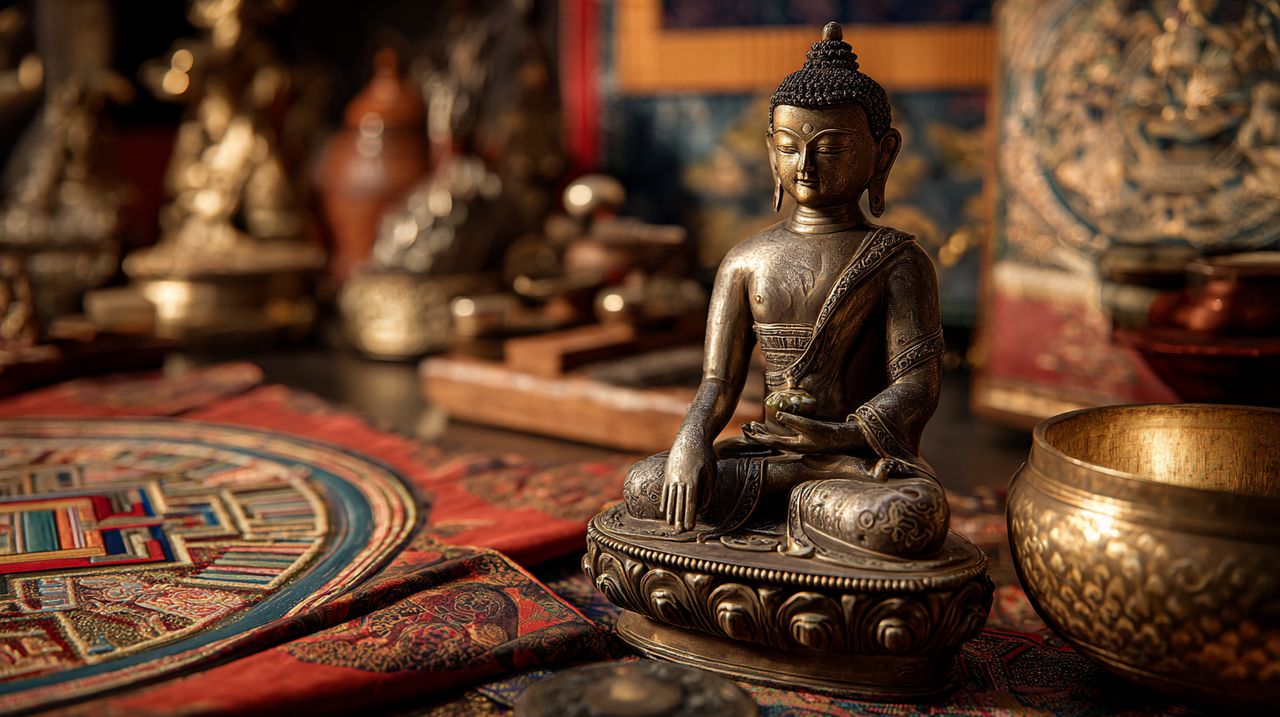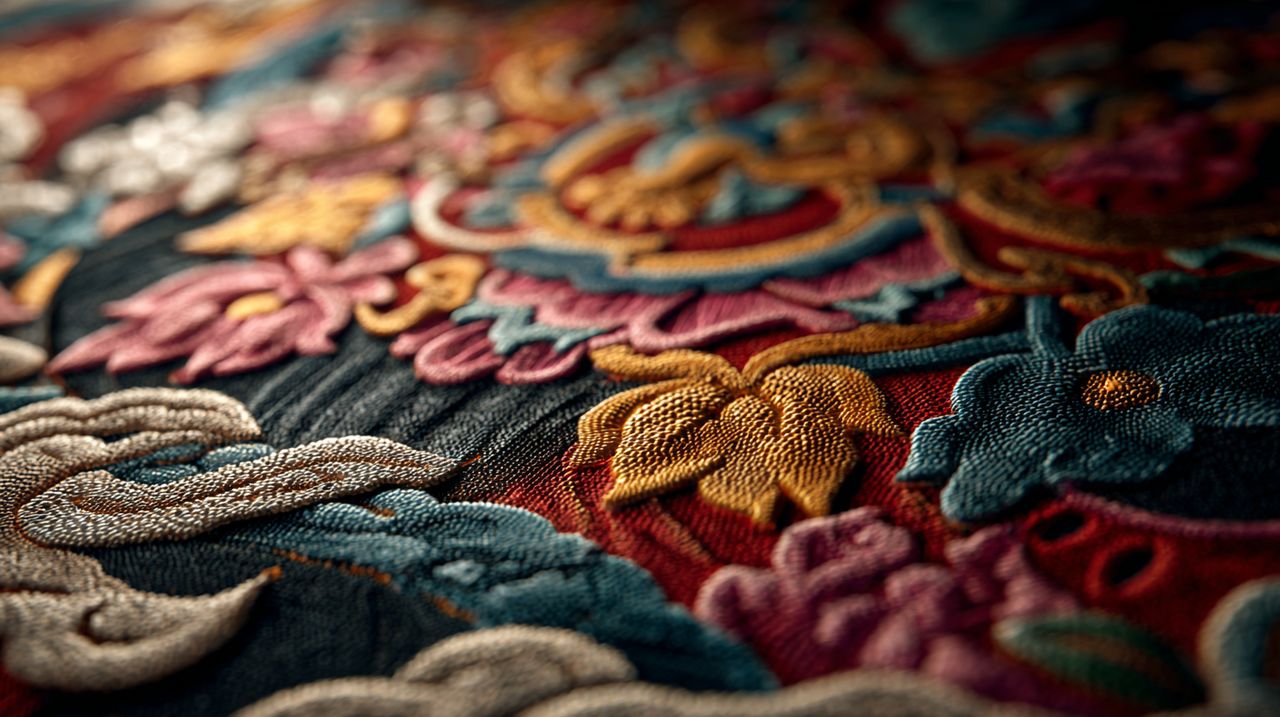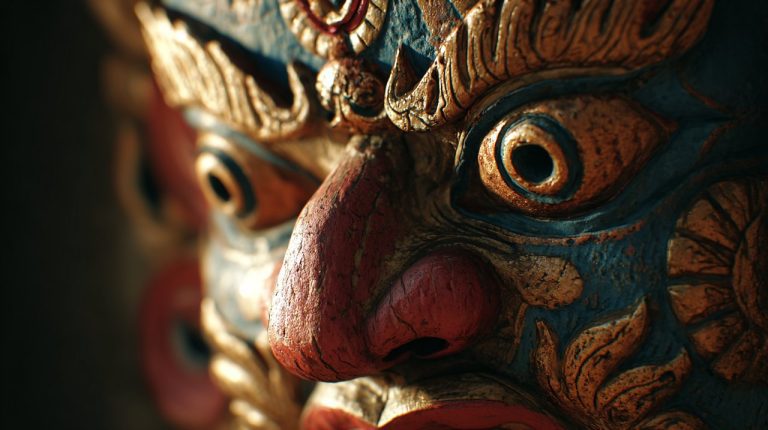Tibetan Artwork: Visual Dharma, Sacred Symbolism, and Meditation’s Canvas
Tibetan culture, with its rich tapestry of philosophy and spiritual practice, offers a profound perspective on the nature of reality. Central to this worldview is Tibetan Artwork, a sacred tradition that extends far beyond mere aesthetic appreciation. These creations are not simply decorative objects or historical artifacts; they are, in essence, living embodiments of the Dharma, meticulously crafted guides for spiritual practice, and potent catalysts for profound meditation.
This exploration will delve into the profound symbolic meaning and spiritual function of iconic Tibetan art forms, including thangkas, mandalas, and Buddha statues. We will uncover how these visual masterpieces serve as dynamic tools, inviting practitioners into a deeper understanding of Buddhist teachings and charting a course for their personal spiritual journeys.

Tibetan Art: Visual Dharma and Spiritual Journey
Far from being static images, Tibetan Artwork functions as a dynamic language, articulating the nuanced philosophical truths of Tibetan Buddhism. Each line, every color, and indeed, every figure is imbued with specific meaning, effectively transforming the artwork into a visual scripture.
These pieces are not merely observed; rather, they are designed to be actively engaged with, serving as pivotal focal points for contemplation and powerful vehicles for spiritual transformation. This unique art form provides a direct pathway to understanding complex doctrines, rendering abstract concepts tangible and accessible. It skillfully bridges the gap between the intellectual comprehension of Dharma and its experiential realization, guiding the mind towards clarity and profound wisdom.
The Cosmic View of Thangka: Profound Depths in a Small Space
Among the diverse expressions of Tibetan Artwork, thangkas—the painted or embroidered scrolls—are arguably the most widely recognized. These intricate pieces are considerably more than simple paintings; they are revered as portable temples, essential teaching aids, and sacred objects of veneration.
Origins and Evolution of Thangka
The emergence of thangkas is deeply rooted in Tibet’s nomadic heritage, where they served as easily transportable representations of deities and Buddhist teachings. While early thangkas were often characterized by their simplicity, they underwent centuries of evolution, blossoming into highly sophisticated works of art. This development saw the integration of diverse regional styles and increasingly elaborate iconographic details.
Their progression mirrored the very spread and deepening of Buddhist philosophy across the vast Tibetan plateau. Monasteries naturally became the epenters of thangka production, where master artists meticulously trained apprentices in this sacred craft. Each thangka thus stands as a powerful testament to generations of unwavering artistic and spiritual dedication.
The Dharma of Painting: Thangka’s Composition and Symbolism
It is crucial to understand that every single element within a thangka carries profound symbolic weight. The composition adheres to strict iconographic rules, ensuring that deities are depicted with absolute precision and their specific attributes. These elements collectively convey layers of meaning:
- Deities and Buddhas: Each figure embodies particular qualities of enlightenment, such as boundless compassion (Avalokiteshvara), pristine wisdom (Manjushri), or healing solace (Medicine Buddha). Their postures (asanas) and hand gestures (mudras) are not arbitrary but convey specific teachings and states of being.
- Colors: Colors are far from arbitrary; they are carefully chosen to represent elemental forces, various states of mind, or distinct aspects of enlightenment. For instance, the serene blue often signifies wisdom or the vastness of the sky, while the vibrant red can represent passion skillfully transformed into compassion.
- Symbolic Objects: Elements like lotus flowers, vajras, jewels, and ritual instruments frequently appear, each carrying layers of meaning related to purity, indestructibility, or the arduous path to liberation.
A framed thangka is typically encased in exquisite silk brocade, a practice that ritualistically elevates its status as a sacred object suitable for altars and devotional practice. This framing not only provides vital protection for the artwork but also ceremonially sets it apart as a consecrated object of profound focus.
From Canvas to Consecration: Thangka’s Spiritual Function
Thangkas hold an undeniably central place in Tibetan Buddhist practice. Their utility extends across multiple spiritual functions, each vital to a practitioner’s journey:
- Meditation Aids: Practitioners utilize thangkas for visualization practices, intently focusing on the deity’s form, colors, and symbols to cultivate specific qualities within themselves, much like a Buddhist mala aids in mantra recitation and concentration.
- Teaching Tools: Lamas adeptly employ thangkas to illustrate complex Buddhist narratives, fundamental principles, and the sacred lineage of teachings to their students.
- Objects of Devotion and Blessing: A properly consecrated thangka is believed to embody the very presence of the deity, thereby offering blessings and spiritual protection to those who venerate it. It stands as a constant, potent reminder of the path to enlightenment.
"A thangka is more than an image; it is a mirror reflecting the practitioner’s inner landscape and a window into the enlightened mind."

Mandalas and Buddha Statues: Three-Dimensional Guides to Practice
Beyond the intricate world of thangkas, the equally profound forms of mandalas and Buddha statues offer distinct yet equally potent avenues for spiritual engagement and profound insight.
Mandalas: Cosmic Order in the Sacred Circle
Mandalas, typically rendered as circular diagrams, are intricate representations of the cosmos or the pure abode of a deity. They are revered as sacred spaces, meticulously constructed to facilitate meditation and profound spiritual instruction. Their complex geometry and precise iconography symbolize the universe’s inherent order and the transformative path to enlightenment.
The structure of a mandala often features a central deity or symbol, encircled by concentric patterns of circles and squares, complete with gates and palaces. This deliberate structure serves to guide the practitioner inward, towards the core truth. Like thangkas, mandalas employ specific colors and strategically place particular deities in designated directions, each representing an aspect of wisdom or a crucial stage on the spiritual journey.
Engaging with a mandala can be likened to entering a spiritual map, where each path and chamber imparts invaluable lessons. It serves as a sophisticated visual guide for the mind, enabling it to navigate the complexities of existence and ultimately arrive at a state of profound inner peace and understanding.
Buddha Statues: Embodiments of Enlightenment
Buddha statues, expertly crafted from a variety of materials such as bronze, wood, or clay, are three-dimensional representations of enlightened beings. It is vital to clarify that they are not worshipped as idols; rather, they are revered as potent symbols and constant reminders of the qualities of awakening that lie dormant within us all. Each statue’s form, posture, and mudras are deliberately chosen to convey specific teachings:
- Sitting Postures: The iconic lotus position (Vajra-asana) profoundly signifies meditation and the attainment of enlightenment, while the earth-touching gesture (Bhumisparsha mudra) represents the Buddha’s pivotal moment of awakening.
- Standing Postures: These often depict the Buddha in a state of teaching or offering protection to sentient beings.
- Hand Gestures (Mudras): These are particularly rich in meaning and convey precise messages:
- Dharma-chakra Mudra: The gesture symbolizing the teaching of the Dharma.
- Abhaya Mudra: The gesture of fearlessness and protective reassurance.
- Dhyana Mudra: The gesture of profound meditation.
These statues serve as enduring visual anchors, continually inspiring practitioners to cultivate compassion, wisdom, and inner peace in their own lives, reflecting the very qualities they embody.
Art and Practice: Bridges to Deep Meditation
The true power of Tibetan Artwork is fully realized not in passive observation, but in its active application as a sophisticated tool for meditation and profound spiritual development. It is through this deliberate engagement that its most transformative benefits are unlocked.
The Art of Visualization: Using Tibetan Artwork for Deep Meditation
Tibetan Buddhist meditation frequently incorporates the practice of visualization, where the artwork itself becomes a precise template for mental imagery. Practitioners typically engage through a structured process:
- Gazing (Shamatha): The practice begins by gently gazing at a thangka or statue, allowing the eyes to absorb every detail without fixation. This initial step is crucial for stabilizing the mind.
- Internalization: Next, one closes the eyes and endeavors to reconstruct the image internally, focusing intently on its colors, forms, and profound symbolic meaning.
- Identification: Through sustained visualization, the practitioner gradually begins to identify with the enlightened qualities represented by the deity, thereby cultivating those very qualities within their own being.
Consider the daily ritual of a monk sitting before a serene Buddha statue. His gaze is not merely seeing; it is a profound communion. He focuses on the Buddha’s compassionate smile, the relaxed posture, the hand gesture of fearlessness. Gradually, the external form seems to dissolve, and the qualities of compassion and fearlessness are not just observed but truly felt within his own being, guiding him towards a state of profound inner peace and awakening.
The Power of Art: Transmission and Enlightenment
These sacred art pieces are far from static relics of a bygone era; they are, in fact, living conduits of spiritual energy and timeless wisdom. Passed down through countless generations, they carry the blessings and profound insights of innumerable masters and dedicated practitioners. Each deliberate stroke of a thangka, each graceful curve of a statue, embodies a rich lineage of enlightenment.
They serve as a continuous, unbroken thread, seamlessly connecting contemporary practitioners to the ancient wisdom of the Buddhas. This profound transmission inspires and guides, powerfully reinforcing the timeless relevance of the Dharma in an ever-changing world.
Collecting and Preserving: Integrating Sacred Art into Life
For those genuinely drawn to the profound beauty and spiritual depth of Tibetan Artwork, integrating these pieces into one’s life can be a deeply meaningful act. However, this endeavor necessitates both discernment and a profound respect for their inherent sacred nature.
Discerning Authenticity and Value: Choosing a Sacred Artwork
When considering any piece of Tibetan artwork, such as thangkas or even rare Dzi beads, wisdom and responsibility are paramount. The focus must extend far beyond mere aesthetic appeal, delving into the deeper aspects of the piece:
- Source and Lineage: It is essential to seek out reputable dealers or artists who possess a deep understanding of and respect for these sacred traditions. Inquire diligently about the artwork’s origin and the artist’s rigorous training within the lineage.
- Craftsmanship: Authentic pieces consistently demonstrate meticulous detail, unwavering adherence to traditional iconographic rules, and the use of time-honored materials.
- Spiritual Integrity: A truly sacred piece of art is created with profound intention and reverence, embodying the Dharma itself rather than being solely driven by commercial value. Ultimately, it should inspire contemplation, not merely admiration.
Choosing a piece of Tibetan Artwork is, in essence, not merely a purchase; it is the thoughtful adoption of a spiritual guide. This significant choice should always be made with the utmost respect for the venerable tradition it represents.
Consecration and Care of Artworks
Once acquired, Tibetan Artwork demands to be treated with profound reverence. Proper care is not only crucial for its physical longevity but also for maintaining its spiritual efficacy:
- Placement: Thangkas and statues should be placed in a clean, elevated space, ideally a dedicated altar or an area specifically designated for contemplation. It is important to avoid common, disrespectful locations.
- Handling: Always handle these pieces gently and with clean hands, recognizing their inherently sacred nature.
- Maintenance: Protect them diligently from direct sunlight, excessive moisture, and accumulating dust. For thangkas, rolling and unrolling should always be performed with meticulous care.
- Consecration: It is advisable to inquire about traditional consecration rituals, which are believed to imbue the artwork with spiritual power, transforming it into a genuine object of veneration and spiritual focus.
By understanding and deeply respecting the intricate world of Tibetan Artwork, we transcend a mere appreciation of its undeniable beauty. We instead open ourselves to its profound capacity as visual Dharma, a sacred language, and indeed, a powerful canvas for our own spiritual meditation and devotion. Engaging with these timeless creations offers a direct pathway to deeper understanding and profound inner transformation, connecting us to a rich spiritual heritage that continues to illuminate the path to enlightenment, just as it has for centuries.
💡 Frequently Asked Questions
Tibetan Artwork is considered a sacred tradition, serving as living embodiments of the Dharma, guides for spiritual practice, and powerful catalysts for meditation. It acts as a dynamic visual language to convey the complex philosophical truths of Tibetan Buddhism.
The article focuses on three iconic forms of Tibetan art: thangkas (painted or embroidered scrolls), mandalas (intricate circular diagrams), and Buddha statues (three-dimensional representations of enlightened beings).
Thangkas are used as meditation aids for visualization practices, teaching tools to illustrate complex Buddhist principles, and objects of devotion and blessing. They are believed to embody the presence of deities and serve as powerful reminders for practitioners.
Buddha statues are not worshipped as idols but are revered as potent symbols and constant reminders of the qualities of awakening that exist within all beings. Their specific forms, postures, and hand gestures (mudras) are chosen to convey particular teachings and inspire practitioners.
Tibetan Artwork should be treated with profound reverence. They should be placed in a clean, elevated space, ideally a dedicated altar, and handled gently with clean hands. It's important to protect them from direct sunlight, excessive moisture, and dust, and to consider traditional consecration rituals.







